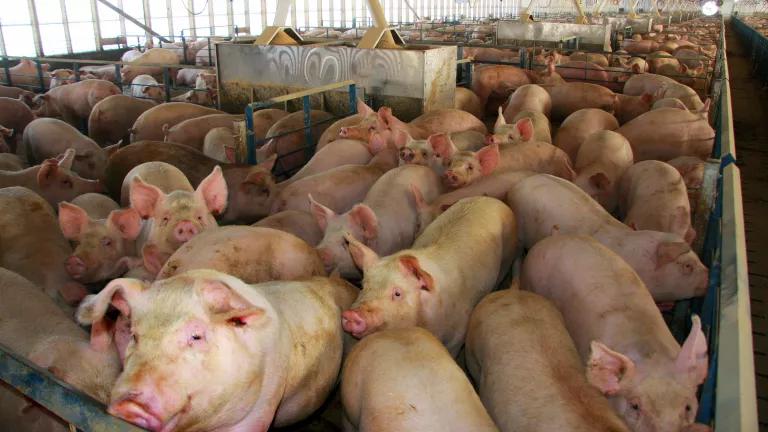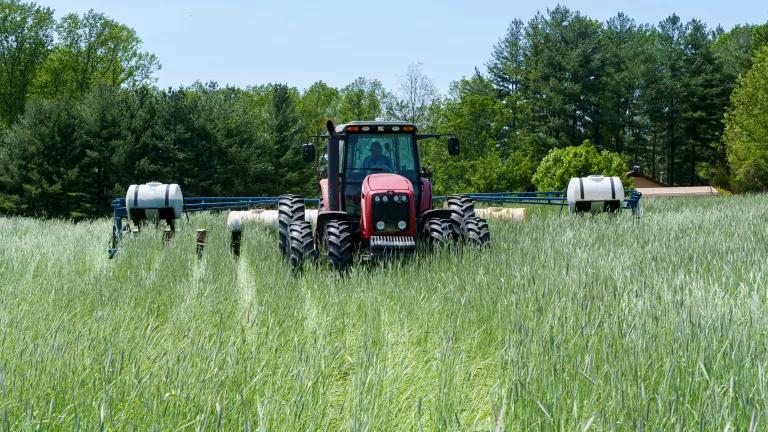Energy From Pig Poop: Industry’s Recent Dupe
Pork producer Smithfield Foods, in partnership with Dominion Energy under the new name Align RNG, have focused their corporate agribusiness agenda on building a network of directed biogas to generate energy from methane gas, rather than investing in cleaner waste management practices at their facilities.

Factory hog farms in North Carolina pose well noted environmental and human health threats from the refuse and pollution they produce. Now, the industrial agriculture sector is trying to profit off of that waste under the guise of renewable energy. Directed biogas projects are not a viable solution to reduce the impacts from hog waste and would further entrench practices that are detrimental to human health and the environment.
Smithfield Foods, the world’s largest pork producer and a major powerhouse in North Carolina—in partnership with Dominion Energy under the new name Align RNG—have focused their corporate agribusiness agenda on building a network of directed biogas, which would generate energy from methane gas (a potent greenhouse gas) rather than investing in cleaner waste management practices at their facilities.
Concentrated Animal Feeding Operations (CAFOs), also known as factory farms, generate an immense amount of waste every year. In North Carolina alone, over 10 billion gallons of fecal matter is created every year by the some 9.5 million hogs that are being raised for slaughter in the state. North Carolina regulation allows the use of the antiquated and dangerous “lagoon and sprayfield,” system which NRDC has been calling for an end to for more than 20 years. Operators store feces in open lagoons—which are often unlined or improperly lined—leading to this waste leaching into the groundwater supply and contaminating it with pollutants like bacteria and excess nitrogen and phosphorus. The contents from these cesspools are then sprayed into the air and onto the land near their operations, in theory to fertilize the land. In reality, this step not only further extends the putrid odor, but can expose communities to health risks, and harm the environment by spreading an excess amount of nutrients far beyond what the soil needs to regenerate. People in these communities, which are disproportionately communities of color, not only see waste being sprayed onto their homes but are forced to inhale the stench.

Over twenty years ago, Smithfield Foods agreed to update their hog waste management systems to include health-protective treatment, but ultimately never did, citing “economic feasibility” as the reason. And now they have proposed a directed biogas project, which involves a large financial investment to build an intricate network of pipelines between its operations and a new factory to burn and process the energy. This reality might make one wonder if the economics have changed. Simply put, they are not prioritizing minimizing the negative impacts of their facilities or making good on their agreement.
Directed Biogas Projects are not a Viable Solution for People and Communities in Eastern North Carolina
Biogas is created when organic material (hog manure) is captured and releases greenhouse gases (primarily methane) which is then burned for energy. Directed biogas does this on a large and organized scale, directing methane gas from many sources in order to profit off of burning it and selling it as energy.
Align RNG is proposing a 30-mile pipeline network, under and between the communities that are already facing the brunt of the health impacts from living near these CAFOs. This directed biogas project would connect 19 hog operations in Duplin and Sampson counties.
Capturing methane from individual or small farms is rarely profitable, so to make it worthwhile, companies often combine the gas from a dozen or more big, industrial operations. In the case of Align RNG, the massive underground infrastructure they are planning to build is an extremely large expenditure that does not invest in community health or safety. This project risks further entrenching the lagoon and sprayfield system and moves the industry farther away from ever updating to a more sustainable and clean waste management technology.
A Stance for Communities and the Environment
Organizations throughout North Carolina and beyond are banding together to take a stance on directed biogas. NRDC, alongside more than 20 organizations and activists, released this position paper to the public in March 2021.
We stand for the health, well-being and fair treatment of our communities and the protection of our state’s natural resources. We object to the abandonment or relaxation of commitments by the pork industry and our elected officials to address harm caused by industrial hog operations. We have waited for more than 20 years for the promised end to the lagoon and sprayfield system of swine waste management and believe all industrial hog operations in the state—including those that produce biogas—must install cleaner technology to prevent harm to nearby communities and our environment.
Not only is this type of biogas a dirty source of energy, but it is not renewable. Covering waste lagoons and transporting methane in a complex underground pipeline has additional environmental and community health risks. Capping waste lagoons increases the concentration of ammonia in the liquid waste that is left after the gas is extracted; the leftovers are then applied to fields. There is runoff from the continued application as well as potential leaching throughout the rest of the directed biogas process including during the digestion, transport and storage steps.
Cleaner management of this waste would ensure that these massive operations reduce or mitigate the pollution they create within their communities. This is especially important as the impacts of climate change increase in intensity, and further destabilize these already inadequate systems.
Take Action
Learn how and engage and take action on this issue here.



